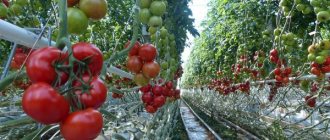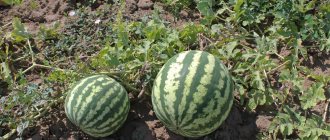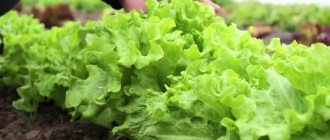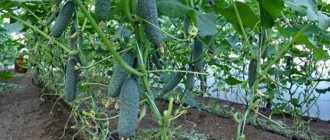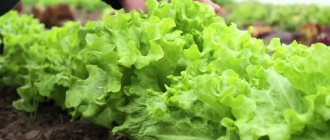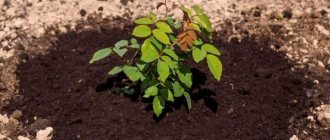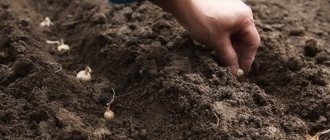Parsley, dill, sorrel and other fresh herbs are rich in minerals, vitamins and various substances beneficial to the human body. There are a lot of microelements, vitamins C and A, folic acid and especially iron in lettuce leaves. In addition, consuming this greenery improves digestion, which is why it is used as a dietary product. Today, almost everyone grows lettuce in their garden plots and dachas. This cold-resistant, unpretentious plant can be planted in beds from early spring to mid-summer to always have fresh greens. We will tell you how to properly plant lettuce and care for it in our article.
Description and best varieties of salad
Since the plant has many species, its appearance is difficult to describe.
On a herbaceous plant, basal leaves first develop, and then a flowering stem, the height of which can be 60-120 cm. Large lettuce leaves can be smooth and corrugated, curly and wrinkled, whole or cut. Only fresh leaves, which contain large amounts of minerals and vitamins, are suitable for food. As soon as the stem begins to grow, they develop a bitter taste.
The lettuce plant has four varieties, each of which is represented by many varieties.
Leaf salad
This plant species eats only leaves, which can have different colors and shapes. Popular varieties of lettuce:
- Sandwich - an early ripening variety with wavy light green leaves, suitable for making salads and sandwiches.
- Lollo Rosso - a plant with a rosette of wavy burgundy leaves has a pleasant taste and will decorate the site. The variety is mid-season.
- Zabava - a mid-season variety characterized by large bright red leaves and resistance to stemming and diseases.
- Dubachek - a plant with light green oblong wavy leaves has the peculiarity of growing new leaves instead of cut ones. The variety is mid-season.
- Ballet lettuce is suitable for growing not only in summer on the site, but also in winter and spring at home and in greenhouses, as it is resistant to lack of light. Its dark green fan-shaped leaves look very beautiful as they have a scalloped edge.
- Riviera - the leaves of this mid-season variety are similar to oak leaves. The plant is resistant to flowering, has good yield and excellent taste.
Half head lettuce
The leaves of this species are collected in open heads. The best varieties:
- Kucheryavets Gribovsky is a mid-early variety with juicy, tasty and crispy bright green leaves, the edges of which are slightly corrugated. The plant is disease resistant.
- Boston - a plant with wavy edges of light green leaves is a loose semi-head. What makes this variety popular is its excellent taste and high yield.
- Berlin yellow - this variety is distinguished by yellowish leaves and a round rosette weighing up to 200 grams. Medium ripening plant.
- Eurydice – The dark green and crisp leaves of this salad have a great flavor. The compact half-head has a semi-raised rosette. The variety is mid-season.
Head lettuce
The cabbage-like plant consists of leaves that have a strong crunch. The best varieties:
- Four seasons - a variety with excellent taste qualities is also interesting for the color of the leaves, which are yellow-green inside and have a bronze-red hue on the outside. It can be grown in greenhouses and in open ground beds. The variety is mid-season.
- Kolobok - the plant is a round, smooth head of cabbage consisting of bluish-green leaves. The variety is characterized by high yield and excellent taste. From germination to ripening – 90 days.
- Great Lakes is a variety with a large round head and crisp, dark green, oak-shaped leaves. The plant is resistant to burns and flowering. Late ripening variety.
- Adamant – this variety will need only 50 days to ripen. It has slightly lumpy, dark green leaves with a nutty flavor. The plant is resistant to bolting and weighs about 350 grams.
You will be interested to know: Spinach: secrets of planting and care, when and how to sow seeds
Scientific classification of lettuce culture
Lettuce or scientifically “lettuce” is an annual plant of the Asteraceae family. There are two varieties of lettuce plants: 1. Lactuca sativa var. secalina leaf lettuce. 2. Lactuca sativa var. capitata head lettuce. Its leaves form a dense head. From the beginning of the growing season, a rosette of lower basal leaves develops, and then a stem is formed. The inflorescences-baskets are small, shaped like a pitcher, forming cylindrical heads. The flowers of the plant are bisexual, small, yellow in color. The fruit of the plant is an achene with a fly.
| Scientific classification of Lettuce, Lettuce (Lactuca sativa) |
| Domain: Eukaryotes Kingdom: Plants Division: Flowering Class: Dicotyledons Order: Asteraceae Family: Asteraceae Genus: Lettuce Species: Lettuce sativum
Cultivating lettuce greens for sale is very profitable, especially during the winter months. A properly thought out and arranged greenhouse, even with a small size, allows you to earn money every year. The plant is characterized by rapid growth, is practically not susceptible to diseases, and the yield of lettuce in the greenhouse is high. The benefits of salad are due to the rich content of vitamin compounds and minerals. Excellent taste has a positive effect on sales of greens. Not many people decide to start growing watercress in a greenhouse. For personal consumption, it is quite possible to grow lettuce on a windowsill in winter. In the southern regions, growing greenery on the balcony of an apartment or the enclosed veranda of a private house will help satisfy the needs of greenery for a small family. You can grow lettuce in a hydroponics system. Before you start growing lettuce in a greenhouse, it is important to study all the features and pitfalls of greenhouse production. An error in calculations can lead to losses instead of the expected income What are the advantages of growing lettuce in a greenhouse:
Disadvantages of growing crops in greenhouses
|
When to plant lettuce in seedlings and in the ground in 2022
Lettuce seeds can be sown directly in open ground, and to obtain greens in early spring, plants are grown through seedlings or in greenhouses.
According to the Lunar calendar in 2022, favorable days for sowing lettuce seeds are:
- in January: 3, 6, 7, 8, 10, 11, 12, 13, 16, 17;
- in February: 2, 3, 4, 7, 8, 9, 12, 13, 14;
- in March the best days are 3, 6, 7, 8, 10, 12, 13; you can start planting during the waning moon from 19 to 26, 29, 30;
- in April: 3, 4, 8, 9, 15 are the best days, you can sow from 17 to 22, 26, 27;
- in May: 2, 5, 6, 7, 13, 14, 15 or from 17 to 20, 23, 24, 27, 28, 29;
- in June: 1-3, 9-13, 15-16, 19, 20, 24, 25, 30.
Unfavorable days for sowing and planting:
- January: 2, 4, 5, 18, 31;
- February: 1, 16, 18;
- March: 1, 2, 18, 27, 28;
- April: 1, 16, 23, 24, 30;
- May: 16, 21, 22, 30;
- June: 14, 17, 18, 29.
Greenhouse requirements
Growing lettuce in a greenhouse will be effective if all requirements for the planting site are met. Before cultivating a plant indoors, it is important to study the features of this method of producing greens.
Comment! If you make mistakes in care and calculations, you may end up with a loss instead of a profit.
The room in which lettuce will be grown must meet the following requirements:
- High quality material. To keep the greenhouse warm in winter, the structure must be reliable, preferably standing on a foundation. Its size is chosen based on the purpose of cultivation. It will not be possible to harvest a large harvest from a small area, but a spacious greenhouse will take a long time to pay for itself. For a small business, a structure of 8-10 square meters is quite enough. Its optimal size is 500x200. You can choose the covering material: film, polycarbonate, glass, for the frame: metal, wood.
- Good heating. It is most convenient to use infrared heating devices to warm up the greenhouse. In addition, a wood-burning stove can be installed indoors. Mulch and agrofibre will help maintain the temperature well.
- High-quality watering. When growing lettuce in greenhouse conditions, it is especially important to ensure regular watering with warm and clean water. The best option is a drip irrigation system.
Some people make greenhouses with their own hands
Growing lettuce from seeds
Growing lettuce seedlings
Sowing for seedlings begins a month before planting in open ground. You can sow seeds at home in seedling containers, or you can grow seedlings in a greenhouse or greenhouse:
- The soil mixture for sowing seeds can be used ready-made or mixed independently from humus soil, peat and sand (2:1:1).
- Before sowing, seeds are disinfected for three hours in a pink solution of potassium permanganate.
- The seedling boxes are filled with moist soil, in which grooves are made 1 cm deep. The distance between the grooves should be about 5 cm, and between the seeds - about 10 cm. You can sow the seeds more often, but then the seedlings will have to be planted.
- The crops are sprinkled with a small layer of soil, watered abundantly (preferably with a spray bottle) and covered with polyethylene on top.
- Seedling containers are placed in a warm and bright place. Before emergence, the cover is removed daily to ventilate the soil. The dried top layer of soil is moistened with a sprayer.
If the planting material is of high quality, shoots may appear already on the third or fourth day. To prevent them from starting to pull out, the seedlings are removed to a well-lit place with a temperature of +15..+18 degrees.
If the seeds were planted frequently, a pick is made when the second true leaf appears on the seedlings. Bushes with 3-4 true leaves are ready for planting in open ground. A week before planting in the garden, the seedlings begin to harden off.
Lettuce seedlings are planted in open ground in warm weather (night frosts down to -2 degrees are allowed). The bushes are planted according to the following scheme:
- large plants - 35x35 cm;
- early ripening compact varieties - 25x25 cm.
Seedlings planted in the ground are sprinkled with soil so that the root collar is at ground level. Planted plants are well watered.
Growing lettuce in a greenhouse
Since lettuce seeds can hatch at a temperature of +5 degrees, it can be planted and grown in a greenhouse even in winter, provided that the room is heated. However, in the future the plant needs a temperature of about +20 degrees for growth and development. Therefore, you can plant lettuce seeds in an unheated greenhouse from mid-March to the end of April (depending on the region).
You will be interested to know: What greens can be planted before winter: list, timing and features of planting greens in open ground in the fall
It is recommended to prepare the soil in the greenhouse for growing lettuce in the fall:
- Add 15 grams of potassium chloride and 40 grams of superphosphate for each square meter.
- Dig up the soil along with fertilizers.
- If the soil is acidic, it is recommended to add slaked lime or dolomite flour (the rates depend on the degree of acidity of the soil). Also, the acidity level will help level out rotted manure.
In the spring, the bed needs to be loosened, leveled and grooves made in it at a distance of 10 cm from each other. The seeds are planted to a depth of 1-2 cm, sprinkled with soil and watered. Since subzero temperatures are not uncommon in early spring, it is recommended to sprinkle the bed with mulch in the form of fine humus.
When the seedlings sprout and grow a little, they are thinned out so that the distance between the specimens is 15-20 cm.
Caring for lettuce in a greenhouse involves abundant but not frequent watering, weeding, loosening the soil, and fertilizing. Fertilizers are applied twice during the growing season. The last fertilizing should be done no later than a month before harvest. As fertilizers, use a solution of 10 liters of water and ammonium nitrate with potassium chloride (half a teaspoon of each preparation).
Headed varieties
Headed varieties are characterized by high yields, but also a longer ripening period. They have higher requirements for agricultural technology than leaf varieties. Plants require good lighting; if there is a lack of light, the heads may stretch out. To get the harvest earlier, seedlings are planted in a greenhouse no later than the first ten days of September.
The most widespread varieties are: Khrustishchiy, Iceberg, Krupnokochanny, Podmoskovye, Azart, Maisky Maslenichny.
Iceberg is a popular lettuce variety. It takes first place in the ranking due to its valuable taste. The weight of the plant can reach 800 grams or more. The leaves are juicy, crispy, collected in a dense head. Iceberg has many varieties, including: Kuala, Fioret RZ, Argentinas, Optimist, Sandpiper, Fortunas. The average weight of Iceberg lettuce reaches 600 g or more. The ripening period averages 60 days. Iceberg is perfectly stored and transported and does not lose its commercial qualities for a long time.
Great Lakes is a new (similar to Iceberg) cabbage variety, has a crispy leaf, is characterized by late ripening (75-85 days), and high yield. When grown in greenhouses, you can get a harvest earlier.
When to plant lettuce in open ground in spring
From mid-April you can start sowing lettuce in open ground. However, everything depends on the climate of the region. It is necessary to focus on the weather, since night frosts should not fall below -2 degrees. Therefore, in Siberia and colder areas, lettuce begins to be sown in open ground in May.
Planting can be done every two weeks so that healthy greens can be eaten until late autumn. Mid-season and late varieties are sown until mid-June. Varieties with a short growing season can be planted until mid-August. However, you should know that at +20 degrees, lettuce seeds germinate worse than at lower temperatures.
Which varieties are best suited for greenhouses and features of their planting
Head, leaf and asparagus lettuce can be successfully grown in a greenhouse. But leaf varieties have proven themselves best. Eg:
- "Parliament" or "Moscow greenhouse",
- And also watercress, which is considered the fastest-ripening and at the same time unpretentious crop.
Note. Already twenty days after planting, they develop a rosette of at least ten leaves. And after a maximum of three weeks, you can begin harvesting. Leaf crops can be seeded every two weeks, guaranteeing a virtually constant harvest.
Features of planting leaf and head lettuce:
| Lettuce varieties | Optimal landing time | Landing method | Landing conditions |
| Head lettuce | From January to April and from September to December | Seedling method/sowing seeds in the ground | Sowing of seeds is carried out at a distance of at least twenty-five centimeters. Seedlings are planted in open ground no earlier than the thirtieth day after emergence. |
| Leaf salad | From January to April and from September to December | Sowing seeds in the ground at the rate of 0.5 grams per 1 meter of soil | The depth of the hole should not exceed ten millimeters, and the distance between individual plants should not be less than twenty centimeters |
Advice. If the distance between individual plants is too small, then it is necessary to carry out the so-called thinning of the crops. The essence of this procedure, as seen in the video, is to remove excess plants from the soil that interfere with the full development of the rest.
As a rule, thinning of crops is carried out twice, the first time at the stage of the appearance of three leaves on the plant, and the second time - five. This procedure makes it possible to harvest from fully developed plants. And the torn lettuce can be used for food.
Rules for planting lettuce in the ground with seeds
For cultivation, choose sunny areas with nutritious soil. It can be loam, black soil and even sand, but not heavy clay soil. Soil acidity should be no more than 7 pH.
The bed for planting lettuce is dug up in the fall, and one bucket of rotted manure or compost is added for each square meter of it. Two weeks before planting in the spring, the area is loosened and fertilized. For 1 sq. meter you will need:
- Mortar – 1 tbsp. l or Nitrophoska, if the soil is acidic;
- potassium sulfate – 1 tsp;
- superphosphate - 1 tbsp. l.
Dolomite flour must be added to acidic soil.
Sowing lettuce seeds in open ground is carried out according to the same scheme as in a greenhouse. When seedlings appear en masse, thinning begins, which is carried out in two stages. As a result, the following distance between plants should be obtained:
- between leaf varieties – 7-8 cm;
- between half-headed and headed – 10-15 cm.
Attention! When choosing a site for planting lettuce, it is important to know that its best predecessors are cucumbers and zucchini, potatoes and cabbage. It is best to plant lettuce with onions in one bed, as this crop repels aphids. Also good neighbors are spinach and peas, radishes and cabbage, tomatoes and strawberries, radishes. The next year, after lettuce, it is best to plant tomatoes and peppers.
Harvesting
Lettuce is harvested no earlier than its leaves reach a height of 8 cm, and the best time for this is the morning, when the plant is still fresh and cooled.
Leaf varieties of lettuce are pulled out along with the root, after which it is cut off, and the dirty lower leaves are carefully removed.
The leaf lettuce harvest is harvested along with the roots.
Head lettuce is cut from the surface of the soil, and pre-watering is prohibited - wet leaves quickly succumb to rotting processes.
The salad can be returned to its original place in no less than 2-3 years.
Greenhouse conditions are ideal for growing lettuce, because here you can best monitor the main indicators that favor the ripening and growth of the plant - light, humidity and temperature. All that is required from the gardener is timely watering, weed removal, shallow loosening and ventilation of the greenhouse. A rich harvest with simple care - this is the basic formula for growing greenhouse lettuce.
Caring for lettuce in open ground
Lettuce care includes the following procedures:
- Watering. Lettuce at an early stage of development is watered once a week. When heads of cabbage begin to form, reduce watering, otherwise parts of the plant may begin to rot. However, the frequency of watering depends on how often it rains. Headed varieties are watered so that water does not fall on the leaves.
- Weeding and loosening. Weeds are removed from the beds as needed, and loosening the soil between the rows is recommended after each watering.
- Feeding lettuce. Leaf varieties growing in nutritious soil do not need fertilizers. In poor soil it is necessary to apply complex mineral fertilizers, which include magnesium and potassium, calcium, phosphorus and nitrogen. Headed varieties are fed with bird droppings (20:1) or mullein (10:1) diluted in water. Solutions are used after watering. And don’t forget that fertilizing is stopped a month before harvest.
You will be interested to know: Sorrel: when and how to plant seeds in open ground in spring, summer and before winter, care and treatment for pests
Preparing for sowing
Before you start growing lettuce, you should learn how to plant and care for it, but first you need to prepare the soil. You will need fairly fertile, organic-rich soil with a slightly or neutral acid reaction. It is recommended to plant lettuce in places where there were previously crops such as cucumbers and tomatoes. The preparation itself will include fertilizing the soil with potassium and phosphate mineral fertilizers (35-40 g of superphosphates and 13-18 g of potassium chloride per 1 m2). Also, to increase productivity, you should add one to two buckets of compost per 1 m2. Lettuce does not like high acidity, so adding lime may be necessary to reduce it. Fertilizers are applied during digging, after which the soil itself must be leveled with a rake. The soil should be prepared after the summer period, but if you have not done this, this can be done immediately after the ground thaws.
Lettuce pests
The most common pests that plague a delicate plant are slugs and aphids, cruciferous flea beetles and wireworms. Since chemicals will be absorbed into the leaves, they cannot be used, so it is recommended to use folk remedies:
- Holes on the leaves indicate that the plant is being eaten by cruciferous flea beetle . Good preventative measures are weeding and regular watering (flea fleas do not like moisture). Planting marigolds, calendula, tomatoes, and garlic nearby will repel the pest.
- Lettuce aphids feed on plant sap, the leaves of which begin to darken and curl. This insect will be repelled by onions planted nearby. You can get rid of the white-winged insect using an infusion of young potato tops, dandelion leaves or onion peels.
- Slugs eat the lower leaves, which result in large holes. Traps are made for these pests: disposable cups are dug in the garden bed, into which a little syrup, juice or beer is poured. The best remedy for slugs is beer, which is harmful to them. However, pests love this drink very much, so if the traps are set in the evening, in the morning you will see many dead slugs in them.
- The wireworm eats the roots of plants. To destroy these pests, there are many folk methods, which we wrote about in our article: How to get rid of wireworms in the garden.
Lettuce diseases
Under unfavorable conditions, non-compliance with crop rotation and agricultural technology, lettuce is affected by diseases, among which the most dangerous for plants are the following:
- White rot - a fungal disease manifests itself as a flaky coating on the leaves and watery light spots on the stems. In parts of the plant, the infection penetrates through leaves touching the ground.
- Gray rot affects plants in high humidity and cloudy weather. The fungus also penetrates leaves lying on the ground, on which brown necrotic spots appear. Spotting from the bottom of the heads and stems moves to the top and spreads throughout the plant. Salads such as Maisky, Khrustalny, and Moscow Greenhouse are resistant to gray rot.
- Powdery mildew is a disease that can be recognized by a cotton-like white coating on leaves, heads of cabbage and stems.
- Edge burn - the disease manifests itself and spreads quickly when there is an excess of nutrients in the soil. The affected plant quickly dies.
- Downy mildew affects crops at high air humidity. The lower leaves are covered with a white coating, and the upper leaves are covered with yellow spots. After some time, diseased leaves turn brown and dry out.
Since chemicals cannot be used to treat diseases on lettuce, preventive measures will protect the plants:
- mandatory compliance with crop rotation;
- disinfection of planting material;
- timely removal of weeds;
- regular watering;
- inadmissibility of stagnation of moisture in the soil;
- growing crops on nutritious soil;
- balanced application of fertilizers.
In the early stages of the disease, it is necessary to immediately remove the affected leaves. If the entire plant is affected, it is pulled out and burned, and the soil is disinfected.
It is recommended to collect lettuce in dry weather in the morning or evening. Raw greens and leaves collected in hot weather will not be stored. Half-headed and head lettuces are harvested after the head has formed, but before the flower shoot appears. During flowering, the taste of greens deteriorates sharply.
The best choice
Experts recommend constructing a glass or film greenhouse on a wooden base for growing lettuce. This design can be supplemented with a second layer of film, which will increase the thermal insulation qualities of the structure. The greenhouse should not only become a reliable structure for growing vegetables, but also a warm, temporary structure. The inside of the greenhouse can be insulated with agrofibre and covered with a second layer of film on top.
An important point is warming up the soil. This must be done with the help of rotting organic matter, which will heat the soil and fertilize it with useful components. In addition, the greenhouse must be equipped with a lighting system so that in winter, when there is not enough sunlight, the lettuce will grow normally. Battery-powered lamps can be used as lighting.
Growing all varieties of lettuce in winter requires heating. The best option is electric heating. If this method seems expensive, you can supplement it with a solid fuel heating system. However, in the second case, the owner’s constant presence on the site is required. Therefore, if you need to go away, it is recommended to turn on the electric heating.
Without watering, growing lettuce in winter and spring in greenhouses is impossible. If the greenhouse is small, watering can be done manually. For large areas, a systemic water supply should be organized. This may be one of the following options:
- Water supply from the water supply system.
- Equipping the irrigation system with a pump that will supply water from the well.
- Filling containers placed in the greenhouse and further watering with settled, warm water.
Experts say that the last option is the most rational. Because in this case, the lettuce will be watered with water at the most suitable temperature. You can learn about the proper arrangement of a greenhouse for growing lettuce from the video clip.
In custody
Growing lettuce is not difficult. This is an unpretentious plant that requires the creation of the simplest conditions. To grow this product in winter and spring, it is recommended to build a greenhouse structure. Properly prepared soil, sufficient watering and the required temperature conditions will allow you to get a rich harvest of lettuce at any time of the year.


